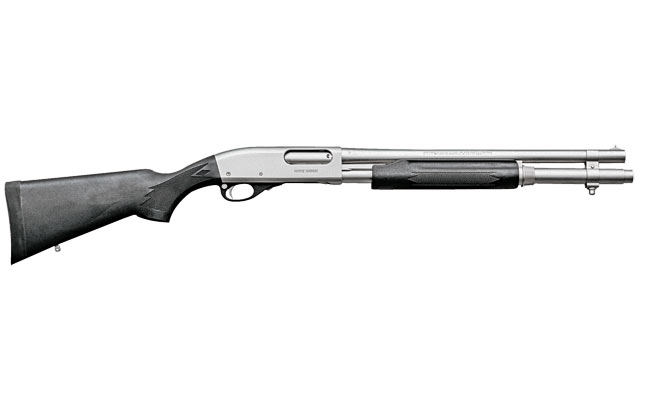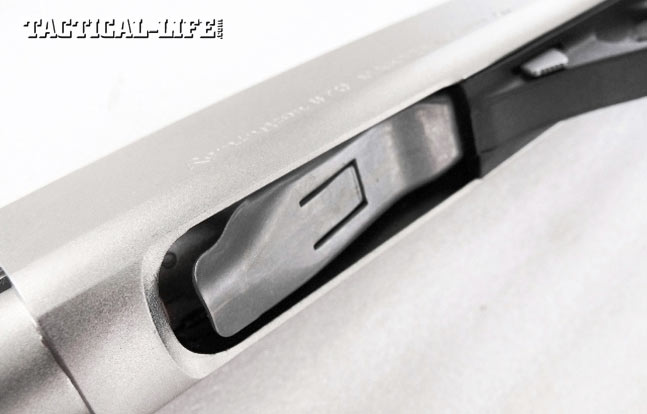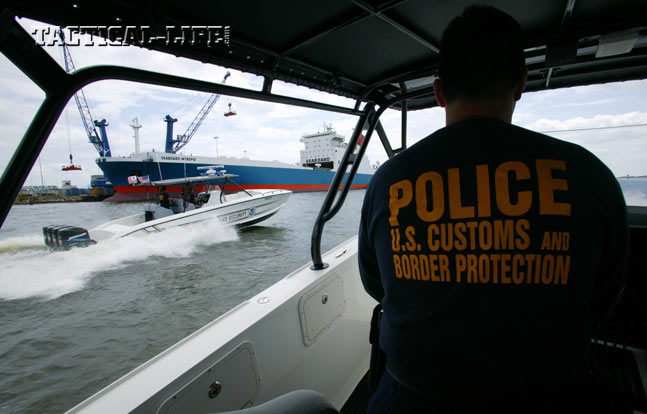The weapon of choice for marine patrols to end high-speed boat pursuits is the Remington Model 870 Special Purpose Marine Magnum, a 12-gauge pump-action shotgun that delivers the firepower needed to stop suspect vessels from reaching U.S. shores. Operating at ports throughout the nation, law enforcement officers and agents patrol oceans, lakes and rivers to prevent the illegal entry of weapons, narcotics and undocumented aliens into the United States. Trained by the National Association of State Boating Law Administrators (NASBLA) or similar organizations, these officers and agents are professionals at intercepting and boarding suspect vessels so their hulls and contraband can be seized and the criminals on board arrested. Not surprisingly, the crews of most vessels involved in criminal activity fail to stop when ordered, and often their engines must be disabled with gunfire to allow the agents on board. It’s in these scenarios where the Remington 870 Marine Magnum shotgun is put into action.

Sea Warrior
Designed specifically for maritime operations, Remington’s pump-action Marine Magnum is purpose-built to resist even aggressive saltwater corrosion, and with a receiver milled from a solid billet of steel, it’s durable enough for harsh duty in dynamic ocean environments. An electroless nickel plating covers its every metal surface, including inside the receiver and the 18-inch barrel, providing a permanent protective finish intended to prevent rust and pitting from exposure. The finish gives the weapon a brilliant and unique silver color that’s sure to make an immediate psychological impact on anyone who staring down the receiving end of the barrel.
Advertisement — Continue Reading Below
The weapon’s basic design is identical to other Remington 870 pump-action shotguns, with a single barrel above the magazine tube, where the shells are carried. A factory magazine extension in a matching finish replaces the usual magazine cap and is fitted underneath the barrel, bringing the shotgun’s capacity to six shells plus one in the chamber. To chamber each shell, the action, or forend, attached to the magazine tube is pulled toward the shooter and then pushed back into place. To ensure this remains a smooth, non-binding action, Remington utilizes twin action bars in its 870 series shotguns, including the Marine Magnum.

A black synthetic stock with ample checkering to improve control brings the weapon’s overall length to a short 38.5 inches and its weight to 7.5 pounds unloaded. Though slower to load and fire than semi-auto models, the manual pump action design doesn’t require the energy of each round fired to cycle the action, and it has no requirement for powerful shells to reliably function. With few limitations, the pump action offers flexibility in selecting ammunition types and enables the mixing of different loads and the use of low-power specialty rounds. A cylinder choke affords agents the ability to fire any 2¾- or 3-inch 12-gauge shell, and with no constriction, consistently distributes pellets in a 30-inch circle at 40 yards and groups slugs within 3 inches at 50 yards. For faster reloads, many agents fit a sidesaddle to the receiver or buttstock, an addition that increases their shell carriage options to 12 rounds.
Because of the modular nature of the 870, those seeking to improve its control and handling have the option of installing a variety of collapsible buttstocks and pistol grips. Picatinny rails that provide tool and optic carriage options are also prevalent, with some fitted to a mount installed over the receiver and others installed directly on the barrel or the sides of the forend. The Marine Magnum has a single bead front sight for aiming, but it’s often supported by a rail-mounted red-dot optic like Trijicon’s Reflex sight. Optics speed up target acquisitions, and with a single illuminated red dot like that of the Reflex, provide aim-point accuracy day and night—critical for high-stress law enforcement situations, especially when firing between moving vessels.
Advertisement — Continue Reading Below

Across The Bow
In practice, officers initiate an intercept by aggressively maneuvering their patrol boat alongside or astern of a suspect vessel, switching on their law enforcement lights, and directing the operator to stop over the radio and loudspeaker. The use of ordnance is immediately suggested as officers advise the suspects to stop or be fired upon. Most vessels stop at this point, but if there is a failure to yield, the officers may attempt to deliver warning shots in the suspect vessel’s path. Twelve-gauge pyrotechnic flares are often used for this purpose, with each round exiting the barrel of the Marine Magnum as a single white star that burns for six to seven seconds. Fired individually or in volleys, they are attention-getting in daylight and at night, and coupled with the presence of their source, a fast-boat close aboard with its lights and sirens energized, their intent is obvious to everyone involved in the chase.
“As a duty shotgun, the Marine Magnum is the professional’s choice, one many officers never leave at the dock…”
If flares fail to the convince the operator to bring his vessel’s engines to neutral, officers may move to forcibly compel the stop with disabling fire, or rounds fired into the vessel’s engines. When necessary, the flares are replaced in the shotgun’s breech with copper sabot slugs, a type of round found to be effective at penetrating fiberglass hulls and cowlings to reach the engine blocks they contain. Once disabled or otherwise stopped, the officers quickly pull alongside the suspect vessel, where they cross over the gunnels and begin directing the suspects into a handcuffing position.
Advertisement — Continue Reading Below
Throughout the process, their movements may be covered by an officer remaining on board the patrol boat, his shotgun loaded with either buckshot or slugs to counter lethal threats or, when the risk is lower, with less-lethal rounds meant to incapacitate. By using a pump action, the officer retains the ability to quickly choose which round is needed to resolve the situation. Once the situation on board is under control and all are detained, the officers begin their investigation and the transit back to shore, where the suspects will be prosecuted.
The Marine Magnum is custom-made for such missions. Like all manual-action firearms, it is inherently more reliable than any semi-automatic shotgun, particularly in the adverse conditions and exposure expected when patrolling on water. Its ability to accept various ammunition types makes it extremely versatile and enables marine patrols to progress through their agency’s levels of force using a single firearm. As a duty shotgun, the Marine Magnum is the professional’s choice, one many officers never leave at the dock.
For more information, visit remington.com or call 800-243-9700.
Advertisement — Continue Reading Below




































